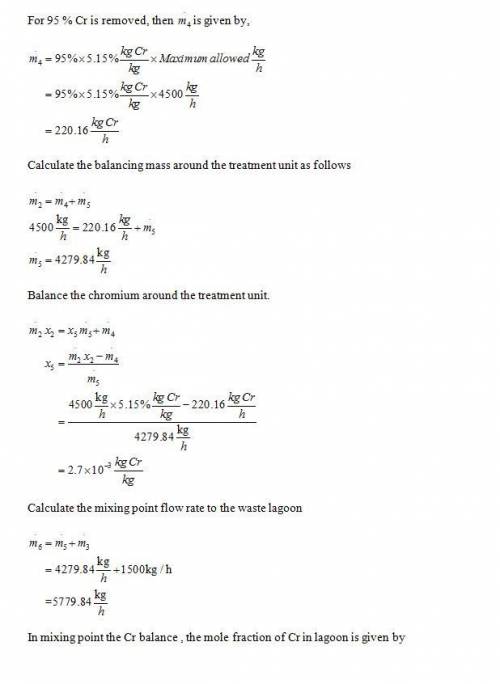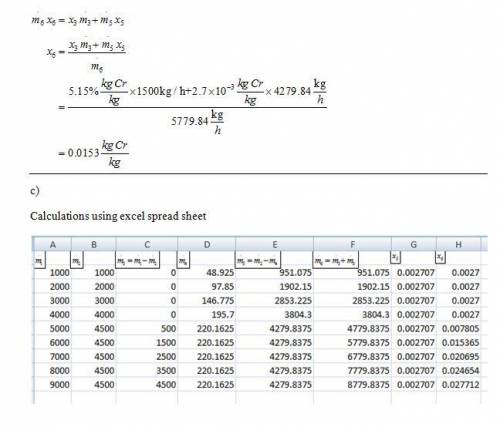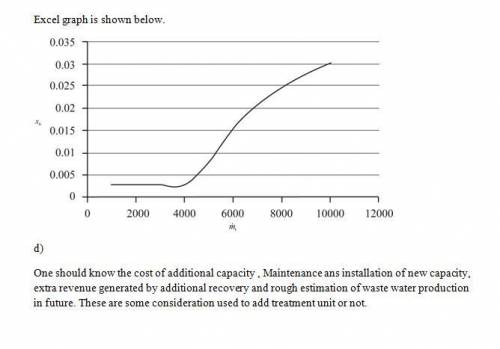
Engineering, 24.06.2020 06:01 ryliepeloquinf
Effluents from metal-finishing plants have the potential of discharging undesirable quantities of metals, such as cadmium, nickel, lead, manganese, and chromium, in forms that are detrimental to water and air quality. A local metal-finishing plant has identified a wastewater stream that contains 5.15 wt% chromium (Cr) and devised the following approach to lowering risk and recovering the valuable metal. The wastewater stream is fed to a treatment unit that removes 95% of the chromium in the feed and recycles it to the plant. The residual liquid stream leaving the treatment unit is sent to a waste lagoon. The treatment unit has a maximum capacity of 4500 kg wastewater/h. If wastewater leaves the finishing plant at a rate higher than the capacity of the treatment unit, the excess (anything above 4500 kg/h) bypasses the unit and combines with the residual liquid leaving the unit, and the combined stream goes to the waste lagoon.
(a) Without assuming a basis of calculation, draw and label a flowchart of the process. (b) Waste water leaves the finishing plant at a rate m_ 1 ? 6000 kg/h. Calculate the flow rate of liquid to
the waste lagoon, m_ 6?kg/h?, and the mass fraction of Cr in this liquid, x6(kg Cr/kg). (c) Calculate the flow rate of the liquid to the waste lagoon and the mass fraction of Cr in this liquid for m_1 varying from 1000 kg/h to 10,000 kg/h in 1000 kg/h increments. Generate a plot of x6 versus m_ 1 .
(Suggestion: Use a spreadsheet for these calculations.) (d) The company has hired you as a consultant to help them determine whether or not to add capacity to the treatment unit to increase the recovery of chromium. What would you need to know to make this determination? (e) What concerns might need to be addressed regarding the waste lagoon?

Answers: 3


Another question on Engineering

Engineering, 03.07.2019 14:10
Amass of m 1.5 kg of steam is contained in a closed rigid container. initially the pressure and temperature of the steam are: p 1.5 mpa and t 240°c (superheated state), respectively. then the temperature drops to t2= 100°c as the result of heat transfer to the surroundings. determine: a) quality of the steam at the end of the process, b) heat transfer with the surroundings. for: p1.5 mpa and t 240°c: enthalpy of superheated vapour is 2900 kj/kg, specific volume of superheated vapour is 0. 1483 m/kg, while for t 100°c: enthalpy of saturated liquid water is 419kj/kg, specific volume of saturated liquid water is 0.001043m/kg, enthalpy of saturated vapour is 2676 kj/kg, specific volume of saturated vapour is 1.672 m/kg and pressure is 0.1 mpa.
Answers: 3

Engineering, 04.07.2019 16:10
An electrical motor raises a 50kg load at a construct velencity .calculate the power of the motor, if it takes 40sec to raise the load through a height of 24m(take g =9.8n/g)
Answers: 2

Engineering, 04.07.2019 18:20
Steam enters a converging nozzle at 3.0 mpa and 500°c with a at 1.8 mpa. for a nozzle exit area of 32 cm2, determine the exit velocity, mass flow rate, and exit mach number if the nozzle: negligible velocity, and it exits (a) is isentropic (b) has an efficiency of 94 percent
Answers: 2

Engineering, 04.07.2019 18:20
How much power could a wind turbine produce if it had the following specifications? cp = 0.45 -d=1.2kg/m3 d=50m v 5m/s
Answers: 2
You know the right answer?
Effluents from metal-finishing plants have the potential of discharging undesirable quantities of me...
Questions








Mathematics, 07.04.2020 21:45


Mathematics, 07.04.2020 21:45




Mathematics, 07.04.2020 21:45

Mathematics, 07.04.2020 21:45

Chemistry, 07.04.2020 21:45

History, 07.04.2020 21:45

English, 07.04.2020 21:45








